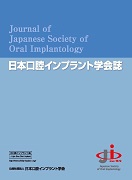Volume 35, Issue 2
Displaying 1-15 of 15 articles from this issue
- |<
- <
- 1
- >
- >|
Reviews
-
Article type: Review
2022Volume 35Issue 2 Pages 53-60
Published: June 30, 2022
Released on J-STAGE: July 25, 2022
Download PDF (1703K) -
Article type: Review
2022Volume 35Issue 2 Pages 61-72
Published: June 30, 2022
Released on J-STAGE: July 25, 2022
Download PDF (2740K)
Special Articles : The Classification of Implant Treatment
-
Article type: Special Articles : The Classification of Implant Treatment
2022Volume 35Issue 2 Pages 73
Published: June 30, 2022
Released on J-STAGE: July 25, 2022
Download PDF (1054K) -
Article type: Special Articles : The Classification of Implant Treatment
2022Volume 35Issue 2 Pages 74-82
Published: June 30, 2022
Released on J-STAGE: July 25, 2022
Download PDF (1501K) -
Article type: Special Articles : The Classification of Implant Treatment
2022Volume 35Issue 2 Pages 83-91
Published: June 30, 2022
Released on J-STAGE: July 25, 2022
Download PDF (1673K)
Special Articles : Dental Implants and Materials : Medical Devices Regulation and the Proper Use
-
Article type: Special Articles : Dental Implants and Materials : Medical Devices Regulation and the Proper Use
2022Volume 35Issue 2 Pages 92
Published: June 30, 2022
Released on J-STAGE: July 25, 2022
Download PDF (1051K) -
Article type: Special Articles : Dental Implants and Materials : Medical Devices Regulation and the Proper Use
2022Volume 35Issue 2 Pages 93-98
Published: June 30, 2022
Released on J-STAGE: July 25, 2022
Download PDF (1311K) -
Article type: Special Articles : Dental Implants and Materials : Medical Devices Regulation and the Proper Use
2022Volume 35Issue 2 Pages 99-104
Published: June 30, 2022
Released on J-STAGE: July 25, 2022
Download PDF (1399K)
Original Papers
-
Article type: Original Paper
2022Volume 35Issue 2 Pages 105-110
Published: June 30, 2022
Released on J-STAGE: July 25, 2022
Download PDF (1284K)
Original Papers
-
Article type: Original Paper
2022Volume 35Issue 2 Pages 111-118
Published: June 30, 2022
Released on J-STAGE: July 25, 2022
Download PDF (1501K) -
Article type: Original Paper
2022Volume 35Issue 2 Pages 119-124
Published: June 30, 2022
Released on J-STAGE: July 25, 2022
Download PDF (1529K) -
Article type: Original Paper
2022Volume 35Issue 2 Pages 125-132
Published: June 30, 2022
Released on J-STAGE: July 25, 2022
Download PDF (1506K)
Case Report
-
Article type: Case Report
2022Volume 35Issue 2 Pages 133-138
Published: June 30, 2022
Released on J-STAGE: July 25, 2022
Download PDF (1971K)
Survey, Statistics and Materials
-
Article type: Survey, Statistics and Materials
2022Volume 35Issue 2 Pages 139-145
Published: June 30, 2022
Released on J-STAGE: July 25, 2022
Download PDF (1520K)
-
Article type: other
2022Volume 35Issue 2 Pages 147
Published: June 30, 2022
Released on J-STAGE: July 27, 2022
Download PDF (938K)
- |<
- <
- 1
- >
- >|
